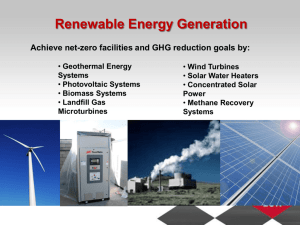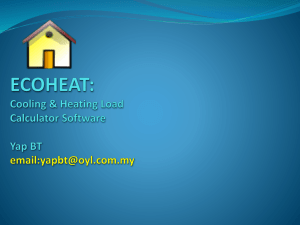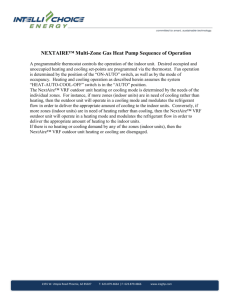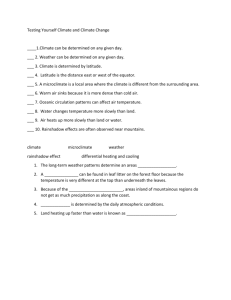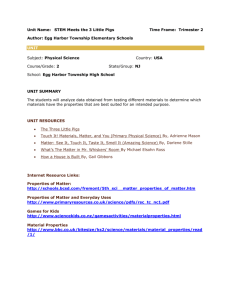Location for a landfill and recycling facility
advertisement
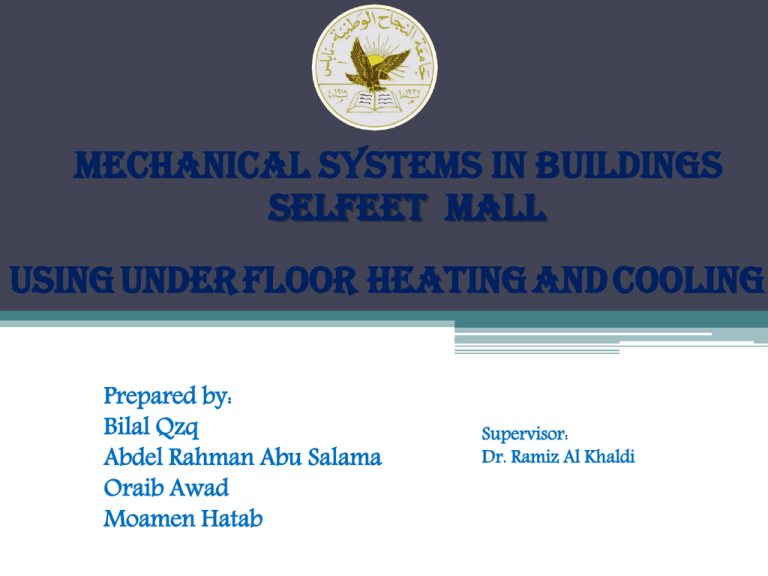
MECHANICAL SYSTEMS IN BUILDINGS selfeEt mall using Under Floor Heating and Cooling Prepared by: Bilal Qzq Abdel Rahman Abu Salama Oraib Awad Moamen Hatab Supervisor: Dr. Ramiz Al Khaldi In our project we will design the following mechanical systems: Under Floor Heating and Cooling Heat Ventilation and air conditioning (HVAC) system in selfeet mall . Plumping system in selfeet mall . Fire fighting in selfeet mall . Building Description selfeet mall building located in Salfeet city, which consists of seven floors. Basement floor, ground floor, first floor, second floor, third floor, fourth floor and fifth floor. Each floors have more one room such as bank, office rooms, shops rooms, and cinema. Under floor radiant cooling system Under floor cooling systems are especially recommended for residential summer cooling and have become an extremely variable alternative to traditional air conditioning systems in recent years. They are comfortable, invisible and silent, whilst offering excellent thermal performance and versatility. Advantages of system 1. Summer comfort 2.Silent working 3.Reduced energy consumption 5. The loss from the floor is less 6. Distributed the air cool is uniform Component of the system 1 ) RNW dehumidifiers and heat recovery units 2 ) Control-Clima Thermoregulation Kit and loops 3) RTU - HUMIDITY AND TEMPERATURE SENSOR 4 ) RT -TEMPERATURE SENSOR Construction of UFC-H system and haw is work The Components in building Kit Control Clima Duplex HPAW-H heat pump RTU humidity and temperature sensor The Components in building Air outlets RNW 404 CS dehumidifier Cover 30 radiant floor system AutoCAD Drawing the under floor cooling skittish figure from Auto CAD to show the RNW with duct connection on system floor and loop (UFC SYSTEM) Designing and calculation(UFC) • 1) Designed for the heat flux (ql)… (w/m^2) • 2) Designed the surface temperature by using figure and depending on pitch (8,16 .. Etc) • 3) Designed for the (RNW) dehumidifier and selection it , depending on air flow and water flow • 4) calculate the condensation by used psychometric chart Condensation • Condensation occurs or not depending on the Dew point , calculate from psychometric charts. • Find Dew point from • 𝒯i =24c0 • Ф=50% • Dp=12.98C if T surfs > T Dp *No condensation occurs if Ts < T Dp Condensation is occurs RNW CS Type RNW construction and work Under floor heating (UFH) Under floor heating (UFH) transfers heat energy by natural radiation from a very large surface which only has to be slightly warmer than the room itself. Radiant energy is emitted from the floor in every direction. layer to construction of (UFH) and install of ceramics type 1- Leveling the ground to become a suitable place. 2- Install the insulation (PE-Foam) on all of the place area 3- Install the carbon films over the insulation and distributes it properly according to the engineering team. 4- Connecting the temperature controller and the heat sensor to the electricity for adjusting the temperature. 5- Put about 2 cm from the sand over the films 6- Connect the heating films to the electricity and try it. 7- Put the concrete and lay the ceramics and tiles. Designing and calculation for (UFH) 1)Heat flux (qL) = Ql/Af ….. w/m^2 2) Floor surface temperature (Tl) Tl =[( ql/8.92) ^1/1.1]+Ti Ti = range from 22 to 24 3)Water temperature (Tk) we can find form figure relation shape between Tl and Tk depending on pipe spacing like (S30 or S25 ) 4) Reverse Heat flow (qk) from figure depending on Tl 5) Total heat load Emitted by pipe (Qe) Qe = (ql+qk)*Af 6)Mass flow reat of water for each loop Mw= Qe/C.p*∆T …….. ∆T = Range from 5 to 8 7) Velocity in the pipe determined by mass flow V = Mw /Ap*ρ …. Diameter for pipe is 16mm Sample calculation: Ground floor: The Bank: Length:28.76m width:9.66m Ti=24 o c , QL=9818 Area=28.76*9.66=277.8m2 qL=QL/Area = 9818/277.8 qL=35.3 Watts/m2 qL=8.92(TL-Ti)1.1 TL=23.5 o c At TL=23.5 and spacing = 30cm we find Tk=27o c At TL=23.5 we find qK=11.2 w/m2 Qe = (qL+qK)*Af . Qe = (35.3+11.2)*277.8 =12929.6 watts. Mw=Qe/Cp.(∆T)=9818/(4.18*1000*7) =0.442 kg/s. D0=20mm, Di=16mm, Thickness=2mm. Vw=((4*Mw)/1000)/(π*0.0162) Vw=2.2m/s. Another example for Sample calculation for first floor Floor (1) Ti /2 Ti (c°) (c°) shop (1) shop (2) shop (3) shop (4) 24 24 24 24 QL( w) from from figure figure qL qk Af ( (w/m^ TL TK (w/m^ Qe m^2) 2) (c°) (c°) 2) (w) 12 10549 191.4 15.40 .5 55.1 6 95 10.8 12 12312 223.4 15.62 .1 55.1 5 68 10.91 12 4831. 29.57 163.3 15.19 566 42 7 98 10.55 12 8434. 31.92 264.2 15.87 45 1 3 83 11.11 Loop m`w V lengt (kq/s) (m/s) h 29 12147 0.484 2.409 192.8 .4 346 682 5 30 13965 0.556 2.770 192.8 .1 822 26 5 29 5689. 0.226 1.128 103.5 218 843 571 097 31 9424. 0.375 1.869 111.72 001 758 441 35 Uniform distribution of air cool Advantages of the system : 1. Simple installation 2. Healthy& comfortable 3. Economic 4. Safe HVAC System HVAC means that Heat Ventilation and Air Conditioning system . The main objective of air conditioning is to maintain the environment in enclosed space at conditions that achieve the feeling of comfort to human. Inside and Outside Condition winter: SUMMER : Outside temperature (To) be Outside temperature (To) be 31.9 8.3˚C. ˚C. Inside temperature (Ti) be 24˚C. Inside temperature (Ti) be 24 ˚C. Outside Relative humidity (Фo) is Outside Relative humidity (Фo) is 72 %. Inside Relative humidity (Фi) is 50%. 44%. Inside Relative humidity (Фi) is 50%. Outside Moisture content (Wo) is Outside Moisture content (Wo) is 4.5 g of water/ Kg of dry air. 16.4 g of water/ Kg of dry air. Inside Moisture content (Wi) is Inside Moisture content (Wi) is 19 g of water/ Kg of dry air. 9.3 g of water/ Kg of dry air Over all heat transfer coefficient, Uoverall Uover all Deponds on the costruction of the unit. Uover all is given by : Uover all = Rtotal = Ri + R +Ro R=∑ The Required UVER All Heat Transfer External wall: No. Material Thicknes Thermal Thermal s conductivi resistance ty (K) (R) ∆X 2 (W/m.K) (m .K/W) Density (ρ) kg/m3 Specific heat (CP) (KJ/Kg.C ˚) (m) 1 Stone facing 0.05 1.7 0.029 2250 1.675 2 Concrete 0.15 1.75 0.0857 2300 0.8374 3 Thermal insulation 0.03 0.04 0.75 25 0.8374 4 Concrete block 0.1 0.833 0.12 1400 0.8374 5 Painted plaster 0.02 1.2 0.0167 1800 0.8374 Internal wall: Thermal Thermal conductiv resistance (R) ity (K) (m2.K/W) (W/m.K) Density (ρ) (kg/m3) Specific heat (CP) (KJ/Kg.C ˚) Material Thickness (m) Painted plaster 0.02 1.2 0.0167 1800 0.8374 Concrete block 0.1 0.833 0.12 1400 0.8374 Ceiling: Thermal Thermal resistance Density (ρ) conductivity (R) (m2.K/W) (kg/m3) (K) (W/m.K) Specific heat (CP) (KJ/Kg.C˚) material Thickness (m) Asphalt concrete 0.02 0.05 0.7 1.75 0.0286 0.0286 2000 2300 1 0.8374 Polystyrenes 0.03 0.05 0.6 25 0.8374 Reinforced concrete 0.03 1.75 0.0171 2300 0.8374 Cement brick (block) 0.15 0.95 0.158 1400 0.8374 Plaster 0.02 1.2 0.0167 1800 0.8374 Windows and doors: Windows and doors The Dimension Thickness bath room Windows 0.8m*0.8m Double clear glass with 6 mm thickness. Rooms Windows 1.2m*1.5m Double clear glass with 6 mm thickness. Rooms Windows 0.7m*0.7m Double clear glass with 6 mm thickness. Internal door 1.2m*2.2 m 50mm thickness with wood External door 3m*2.8m Made from glass. Heat transfer coefficient (U)w/m^2.s. External Wall 3.1 External Wall(glass) 2.67 Internal Wall 2.47 Internal Wall(glass) 3.5 Ceiling 3.5 Floor 5.6 Door(40mm-wood) 0.148 Door(glass) 0.8 Heating load calculation Heating load sources : The heating load calculation begins with the determination of heat loss through a variety of building for components and situations. 123456- Walls Roofs Windows Doors Basement Walls Basement Floors Infiltration Ventilation Heating Load Equations In summer : Tun = Ti+(2/3)( To - Ti ) In winter : Tun = Ti+(0.5)( Ti - To ) Tg= Ti+ ( rang from 5 to 10) Wout Win Φout Φin Tg Tun To Tin Paramet ers 4.5 19 72% 50% 13.3 13.3 8.3 24 Winter 16.4 9.3 44% 50% 36.9 28.8 31.9 24 Summer The following equations were used to calculated the heating load: Qs,cond = U A (Tin – To) . Q s,vent,inf = 1.2 Vvent,inf (Tin – To). Q l,vent,inf = 3 Vvent,inf (Wi- W o). • Vvent = n * value of ventilation • Vinf = (ACH * inside volume *1000) /3600 Qtotal = Qs,cond + Qs,vent,inf +Ql,vent,inf . Heating Load Results NO. of Floor Qtotal(W) Qtotal(KW) Qtotal(Ton) Qtotal(CFM) GF FLOOR 32624.92 32.62492 9.321406 3728.56229 First Floor 41297.46 41.29746 11.79927 4719.70971 Second Floor 36789.54 36.78954 10.5113 4204.51886 Third Floor 3180.01 3.18001 0.908574 363.429714 Fourth Floor 5632.9 5.6329 1.6094 643.76 Top Floor 40849.38 40.84938 11.67125 4668.50057 TOTAL 160374.2 160.37421 45.8212 18328.4811 The boiler is the main source of heating process, selection of boiler depends on its capacity. selection of boilers from De Dietrich company. The total amount of heat in our project equal to 160.37 KW. Use catalog of boilers then the suitable boiler is that of type GT330 DIEMATIC- m3 . Cooling Load calculation Cooling load calculated at summer season. Cooling design conditions (in summer): Outside temperature (To) be 31.9˚C. Inside temperature (Ti) be 24 ˚C. Outside Relative humidity (Фo) is 44%. Inside Relative humidity (Фi) is 50%. Outside Moisture content (Wo) is 12.5 g of water/ Kg of dry air. Inside Moisture content (Wi) is 9.4 g of water/ Kg of dry air. The wind speed at SALFEET is (10.5 m/s). Cooling loads classified by Source : Heat transfer (gain) through the building skin by conduction, as a result of the outdoor – indoor temperature difference. Solar heat gain (radiation) through glass or other transparent materials. Heat gains from Ventilation air and/or infiltration or outside air. Internal heat gain by occupants, light, appliances, and machinery. Cooling load Equations 1 ) For ceiling : Q=U*A*(CLTD)corr Where: (CLTD)corr = (CLTD + LM) K + (25.5 – Ti )+ (To – 29.4) Where : CLTD: cooling load factor K:color factor: K=1 dark color K=0.5 light color 2) For walls : Q=U*A*(CLTD)corr Where: (CLTD)corr =(CLTD + LM) K + (25.5 – Ti )+ (To – 29.4) Where : CLTD: cooling load factor K:color factor: K=1 dark color K=0.83 medium color K=0.5 light color 3)For glass : Heat transmitted through glass Q=A*(SHG)*(SC)*(CLF) SHG: solar heat gain SC: shading coefficient CLF: cooling load factor Convection heat gain: Q=U*A*(CLTD)corr (CLTD)corr = (CLTD)+(25.5 – Ti )+ (To – 29.4) 4 ) For people : Qs=qs*n*CLF QL=qL*n where: Qs,QL: sensible and latent heat gain qs,qL: sensible and latent gains per person n: number of people CLF: cooling load factor 5) For lighting : Qs=W*CLF Where: Qs: net heat gain from lighting W:lighting capacity: (watts) 6) For equipments : Qs=qs*CLF QL=qL Where: Qs,QL: sensible and latent heat gain. CLF: cooling load factor Definition for term of Previous Equations Q : heat loss ( watt) . U : over all heat transfer coefficient (w/m2.k). Tin : inside temperature (C) . To : outside temperature ( C ). LM : Latitude correction factor . SHG: Solar heat gain . SC :shading coefficient . CLF : cooling load factor . CLTDcorr : The correction of cooling load temperature difference. n: number of people. W: lighting capacity. Q vent : the heat losses due to sensible ventilation . Cooling load Results NO. of Floor Qtotal(W) Qtotal(KW) Qtotal(Ton) Qtotal(CFM) GF FLOOR 79923.72 79.92372 22.83535 9134.13943 First Floor 93239.07 93.23907 26.63973 10655.8937 Second Floor 96067.56 96.06756 27.44787 10979.1497 Third Floor 104331.1 104.3311 29.80889 11923.5543 Fourth Floor 155931.3 155.9313 44.5518 17820.72 Top Floor 656141.5 656.14151 187.469 74987.6011 TOTAL 1185634 1185.6343 338.7526 135501.058 The chiller is the main source of cooling process, our selection depends on PETRA COMPANY. The cooling load in our project is 338.752Ton. So we select 350 ton R 134-a chiller it's manufactured with two compressors and with the same compressors type. The Chiller Code is: WPS a 350 2 S Duct Design Grills are calculated and distributed uniformly. The duct is drawn and distributed before calculations The sensible heat of floor is calculated. V circulation is calculated to determine the CFM. The initial velocity is 5 m/s. The loss ΔP/L is determined from figure A.1 by using velocity and V circulation. Area is calculated by: A = V circulation / velocity The main diameter is calculated from figure A.1 At the same (∆P/L). IF the duct rectangular; the height of the duct is known from design its width by dependent on the H and D by using software C. Pipe Design The total cooling load was calculated for the floor. The mass flow rate for the water calculated (m). The pressure head was estimated in (Kpa) . The longest loop from the boiler to the far fan coil unit and return to the boiler was calculated multiplying by (1.5) due to fittings. The pressure head per unit length is calculated and it should be between range from (200< ∆p/L<550). Then the diameter of pipe entering to the floor is estimated . Air Handling Units selection Air handling units are used in both heating and cooling load. They are selected from PETRA COMPANY, we selected Four AHU for the Building. Room name Selection Q (kw) Q (ton) Bank PAH-H-C-50-C-6 H-2 X 2 36.325 10.4 Office PAH-H-C-50-C-6 H-2 X 2 40 11.43 Cinema PAH-H-C-120-C-6 H-2 X 2 85.7 24.5 Restaurant PAH-H-C-62-C-6 H-2 X 2 48.7 14 Waiting room PAH-H-C-40-C-6 H-2 X 2 30.5 8.72 Fan Coil Units selection In Our project we need Ducted FCU and to ensure the high level of comfort we need the filtered FCU our selection from Petra catalogs is CBP type. CBP Ceiling Basic With Plenum (Galvanized Steel) Designed for concealed ceiling installation above false ceiling with ducted supply and return air distribution. The plenum encloses the fan section of the basic unit. Units of this type consist of a coil, fan and a flat filter. Ground floor Room name Fan name Fan selection In door unit type air flow rate (cfm) shop 1 f.C.U 01 - GF DC 06 - M -561 ceiling mounted 561 shop 2 f.C.U 02 - GF DC 10 - M -875 ceiling mounted 875 shop 3 f.C.U 03 - GF DC 06 - M -561 ceiling mounted 561 shop 4 f.C.U 04 - GF DC 12 - M -1056 ceiling mounted 1056 Cost of HVAC system • 135$ /m^2 • Then for 2711 m^2 the total area we need to cooling and heating • Then >> ( A * cost per m^2) if we make calculate : • 1 m^2 refrigeration _____ 135 $ • 2711 m^2 ________ X cost • X = 2711 m^2*135 $/m^2= 365985$ Compare between (UFC_H and HVAC) UFC_H system HVAC system • Temperature distributing • Is Uniform distributing for air cooling and heating • Temperature distributing • Is not Uniform distributing for air cooling and heating • The total cost is : • 314935$ • The total cost is : • 365985$ Plumbing system Plumbing system consist of : 1- Potable water system. 2 - Drainage system. 3 - Fire fighting system Potable water system Plumbing Fixtures The most common plumbing fixtures are : Kitchen sinks. Lavatories (also called bathroom sinks). Urinals. sinks. Water closets. Calculation : 1- calculate of fu. 2- calculate flow rate . 3- calculate diameter . 4- calculate head pressure of the pump. The plumping fixture unit in building Type of No. of fixture fixture Water closet Size of pipe (in) 5 1/2 , 3/8 Lavatory 2 1/2 , 3/8 Kitchen sink 2 1/2 ( w .c ) Drainage System in Building Type of fixture No .of fixture Size of pipe ( in ) Water closet 4 4 Lavatory 1 2 Kitchen sink 3 2 Floor drain 3 2 Fire fighting system Fire Protection Types : 1- Fire Sprinkler System . 2- Fire Extinguisher. 3- landing valve. 4- cabinet . Fire Protection Components : Fire Protection consist of the following components: • Fire pump sets (Main and Standby). •Jockey pump. •Fire Sprinkler. •Branch pipe with nozzles. Calculation fire fighting : •Design of Farthest two landing valve . •Calculate the size and flow rate . •Size of landing valve 2 ½ in , cabinet 1 ½ in. •Flow rate of landing valve 500 gpm (tow landing valve) , and more tow 750 gpm . •Calculate of head pressure for pump Calculation of sprinklers. THANK YOU
